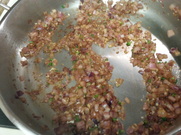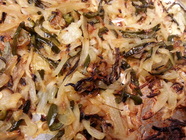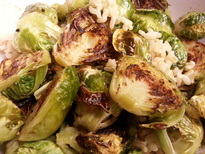In Part 1 I we looked into wet cooking methods, methods that cook the veggies using water. In Part 2, we are going to look at methods for cooking veggies other than those that use water. In other words, dry cooking methods.
Sweating. Not you after running in the hot sun. Sweating is a “low and slow” cooking technique, sweating is a low-temperature technique used at the beginning of cooking to develop flavor in a dish. Finely-cut vegetables such as onions, garlic, bell peppers, or celery are cooked in a skillet with fat or other liquid such as water, vegetable broth, or wine over very low heat until they are completely softened. The purpose of sweating is to slowly release and concentrate the flavors of the vegetables without changing their color. Sweating creates the first “layer” of flavor in a dish, and is especially desirable when preparing soups, sauces, and dishes that are light in color.
Sweating. Not you after running in the hot sun. Sweating is a “low and slow” cooking technique, sweating is a low-temperature technique used at the beginning of cooking to develop flavor in a dish. Finely-cut vegetables such as onions, garlic, bell peppers, or celery are cooked in a skillet with fat or other liquid such as water, vegetable broth, or wine over very low heat until they are completely softened. The purpose of sweating is to slowly release and concentrate the flavors of the vegetables without changing their color. Sweating creates the first “layer” of flavor in a dish, and is especially desirable when preparing soups, sauces, and dishes that are light in color.

Caramelizing. This typically applies to onions, which are cut, then cooked at high temperatures in a skillet that’s been coated with fat or other liquid such as water, vegetable broth, or wine. Sugars in the onions break down and turn brown, causing the flavor to become deliciously sweet, nutty, earthy, and more complex. Like sweating, caramelizing creates a “layer” of flavor and color in a dish that complements stir fries, soups, sauces, and other colorful dishes.

Sautéing. Veggies are cut into bite-size pieces and are then tossed or cooked over high heat until they are either cooked through to a golden-brown color or heated through if already cooked. Higher heat is maintained throughout the cooking process, and the veggies are stirred frequently so that they cook evenly. The veggies quickly cook due to the high heat and bite-size pieces.
Traditionally, oil is added to a hot pan before adding the veggies to prevent the veggies from sticking to the pan. Veggies can also be sautéed in other liquids such as water, vegetable broth, or wine by adding the liquid to the hot skillet before adding the veggies, then adding more liquid throughout the cooking process, a little at a time to prevent sticking, until the veggies are cooked.
Veggies can also be dry-sautéed in either a non-stick skillet or in a stainless steel skillet that has been heated to the point where water forms balls like mercury when water is dripped onto the surface of the skillet, which creates a “non-stick” surface on the stainless steel skillet. The veggies can then be sautéed without using any liquid at all and simply stirring constantly.
The veggies will eventually begin to brown and stick, at which point you can add small amounts of water, vegetable broth, or wine to loosen any veggies that stick (deglaze).
Sautéing with or without oil adds lots of flavor to veggies due to the browning. Some veggies that are great for sautéing include onions, bell peppers (red, orange, yellow, and green), zucchini, summer squash, green beans, broccoli, spinach and other greens, cauliflower, asparagus, lotus root, carrots, snow peas and sugar peas, mushrooms, and others.
Veggies that are sautéed can either be served as is on a plate or over rice or pasta, used as a base to build a sauce, added to soups, or added to anything else you can think of. A great way to enjoy sautéed veggies is to start by dicing and then browning an onion, adding some garlic, then adding the other veggie(s) to be sautéed. Finish by seasoning with a little sea salt and pepper. Yum!
Traditionally, oil is added to a hot pan before adding the veggies to prevent the veggies from sticking to the pan. Veggies can also be sautéed in other liquids such as water, vegetable broth, or wine by adding the liquid to the hot skillet before adding the veggies, then adding more liquid throughout the cooking process, a little at a time to prevent sticking, until the veggies are cooked.
Veggies can also be dry-sautéed in either a non-stick skillet or in a stainless steel skillet that has been heated to the point where water forms balls like mercury when water is dripped onto the surface of the skillet, which creates a “non-stick” surface on the stainless steel skillet. The veggies can then be sautéed without using any liquid at all and simply stirring constantly.
The veggies will eventually begin to brown and stick, at which point you can add small amounts of water, vegetable broth, or wine to loosen any veggies that stick (deglaze).
Sautéing with or without oil adds lots of flavor to veggies due to the browning. Some veggies that are great for sautéing include onions, bell peppers (red, orange, yellow, and green), zucchini, summer squash, green beans, broccoli, spinach and other greens, cauliflower, asparagus, lotus root, carrots, snow peas and sugar peas, mushrooms, and others.
Veggies that are sautéed can either be served as is on a plate or over rice or pasta, used as a base to build a sauce, added to soups, or added to anything else you can think of. A great way to enjoy sautéed veggies is to start by dicing and then browning an onion, adding some garlic, then adding the other veggie(s) to be sautéed. Finish by seasoning with a little sea salt and pepper. Yum!

Roasting. This method concentrates and intensifies the flavor in vegetables by browning and caramelizing sugars at the surface of the veggies. To roast the perfect veggies, start by cutting the veggies into even-size pieces, typically bite-sized, meaning about 1-2 inches. Lightly coat the veggies in an oil such as grapeseed oil or olive oil before roasting to evenly brown the surface of the veggies and keep the inside from drying out (oil prevents moisture from evaporating from within the veggies).
Before roasting, season the veggies with sea salt and pepper to highlight the natural flavor of the veggies. You can add additional seasonings, hearty herbs (such as rosemary or thyme), and/or spices for more flavor. You can also coat the veggies with liquids such as balsamic vinegar, which adds both sweet and sour notes, or vinaigrettes and dressings, which also add flavor. Don’t add too much liquid or the veggies will steam rather than roast.
Spread the even-sized cut veggies out on a greased or parchment-lined baking pan in a single layer without crowding. Place the cut-side down where possible for the best browning. If you are roasting different kinds of veggies, it’s best to roast them separately because different veggies have different cooking times, and this way you can properly cook all veggies.
Most veggies are roasted in a hot oven between 400 & 475 °F. In general, the smaller the veggie, the higher the oven temperature needs to be since it takes less time to cook through and brown.
Bite-size pieces of food are typically roasted at 475 °F to produce a crispy, golden exterior and a tender, moist interior.
Harder, or larger cut veggies are best roasted between 350 & 400 °F to prevent the surface from burning before the veggies are cooked through.
Veggies with high amounts of water (e.g., tomatoes) are slow-roasted at around 250 °F. The lower temperature allows moisture to slowly evaporate, concentrating flavor and deepening color.
Roasting times vary depending on your oven and the size and type of veggies you are roasting.
The baking pan gets hotter along the sides and edges than the interior, so veggies along the sides and edges tend to cook faster than veggies on the inside of the pan. You may have to move veggies around in the middle of the process. Roast until crispy and browned on the outside and moist and cooked on the inside.
Serve the roasted veggies on a plate or a shallow dish. Do not serve in a deep dish or bowl because the pieces at the bottom will steam, and the crispy browned sides will get soggy.
Roasting is great for many veggies, including (but not limited to) cauliflower, broccoli, red bell peppers, chile peppers, sweet potatoes, yams, potatoes, onions, eggplant, zucchini, yellow squash, butternut squash, Brussels sprouts, and mushrooms.
Dry cooking techniques are all about building flavor into the veggies! I never start a dish without first dicing and caramelizing an onion, usually followed by some diced peppers (red bell pepper, jalapenos, serranos, or pasilla peppers), then adding some garlic, sometimes followed by diced fresh ginger, depending on what I’m making. Then I build the rest of the dish on that flavorful base, whether it’s a soup, a sauce, a stew, or a stir fry.
Try it! You will be amazed by how great veggies can taste! These aren’t your mother’s veggies!
Before roasting, season the veggies with sea salt and pepper to highlight the natural flavor of the veggies. You can add additional seasonings, hearty herbs (such as rosemary or thyme), and/or spices for more flavor. You can also coat the veggies with liquids such as balsamic vinegar, which adds both sweet and sour notes, or vinaigrettes and dressings, which also add flavor. Don’t add too much liquid or the veggies will steam rather than roast.
Spread the even-sized cut veggies out on a greased or parchment-lined baking pan in a single layer without crowding. Place the cut-side down where possible for the best browning. If you are roasting different kinds of veggies, it’s best to roast them separately because different veggies have different cooking times, and this way you can properly cook all veggies.
Most veggies are roasted in a hot oven between 400 & 475 °F. In general, the smaller the veggie, the higher the oven temperature needs to be since it takes less time to cook through and brown.
Bite-size pieces of food are typically roasted at 475 °F to produce a crispy, golden exterior and a tender, moist interior.
Harder, or larger cut veggies are best roasted between 350 & 400 °F to prevent the surface from burning before the veggies are cooked through.
Veggies with high amounts of water (e.g., tomatoes) are slow-roasted at around 250 °F. The lower temperature allows moisture to slowly evaporate, concentrating flavor and deepening color.
Roasting times vary depending on your oven and the size and type of veggies you are roasting.
The baking pan gets hotter along the sides and edges than the interior, so veggies along the sides and edges tend to cook faster than veggies on the inside of the pan. You may have to move veggies around in the middle of the process. Roast until crispy and browned on the outside and moist and cooked on the inside.
Serve the roasted veggies on a plate or a shallow dish. Do not serve in a deep dish or bowl because the pieces at the bottom will steam, and the crispy browned sides will get soggy.
Roasting is great for many veggies, including (but not limited to) cauliflower, broccoli, red bell peppers, chile peppers, sweet potatoes, yams, potatoes, onions, eggplant, zucchini, yellow squash, butternut squash, Brussels sprouts, and mushrooms.
Dry cooking techniques are all about building flavor into the veggies! I never start a dish without first dicing and caramelizing an onion, usually followed by some diced peppers (red bell pepper, jalapenos, serranos, or pasilla peppers), then adding some garlic, sometimes followed by diced fresh ginger, depending on what I’m making. Then I build the rest of the dish on that flavorful base, whether it’s a soup, a sauce, a stew, or a stir fry.
Try it! You will be amazed by how great veggies can taste! These aren’t your mother’s veggies!



 RSS Feed
RSS Feed